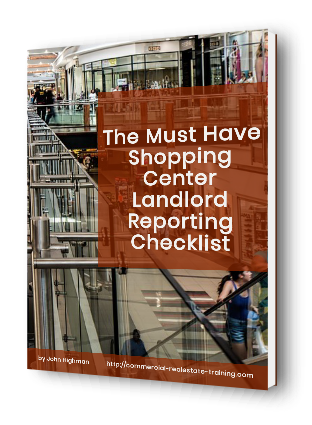The Must Have Shopping Center Landlord Reporting Checklist
The quality of a report to a landlord owning a shopping centre is so important; that is in a variety of ways. Why is that? It is the ‘control tool’ for staying ahead of property issues, changes, and opportunities for tenants, customers, and maintenance contractors. A good report structure and strategy will help the leasing manager and the centre manager with property control and strategic decisions.
The shopping centre manager is the person that prepares the landlord report, and ‘overlays’ all critical elements of property performance across leasing, rents, income, expenditure, risk, and property maintenance. A report to a shopping centre owner is, therefore, both special and controlling. It can be updated regularly; it can be the system or report that facilitates decisions.
It can also be said that the landlord report is a ‘valuable tool of record’ with all current and known facts in a managed property. Most shopping centres are just so busy every day and having a way of consolidating active things into a standard reporting system is wise. When important factors or events happen on the property, they can and should be recorded as part of the landlord report.
Retail Shopping Center Reporting Formats
These items below are the factors of reporting that I have seen as critical to a shopping centre reporting process. The exact order of items mentioned below is open to variation depending on the client and the property report, so choose some that will help with property control and improvement. Add to this list as your landlord or property design may require:
- Monitor the levels of income and the budget – property income impacts values of the asset. The net income is the figure to focus on. On a tenant by tenant basis, there can be different rules and strategies applied to upcoming rent reviews and tenancy leasing activities. The budget for the property is the place to set the rules and the benchmarks to be achieved.
- Rentals set and achieved by zone, and by property precinct or tenant type – there are differences in rent around a property. There are also differences in rents that could be payable by a tenant type. That is why tenant clustering and tenant placement in the overall mix is so important. Leasing strategies in the tenant mix are ever changing to optimize occupancy and minimize vacancy downtime.
- Expenditure activities and budgets – know where the property expenditure is to be spent and when that is to occur. Time the spending of money where possible, so the net income for the property is predictable and controlled.
- Tenant results and meetings – some tenants will be lease ‘active’ and need controlling or monitoring when it comes to occupancy, negotiation, and property performance. Devote a specific section of your property report to that category of tenant monitoring and interaction. Control and direct your tenants to the targets of the landlord and the property as an investment.
- Upcoming rent reviews and strategies – every lease and every tenant rent review should be negotiated to rules and targets. The business plan for the property can have those indicators set for the following 12 months in advance.
- Upcoming vacancy factors and changes in occupancy – always allow for some degree of vacancy factor and a landlord incentive application in the letting of a vacancy in a managed property. The leasing manager for the shopping centre will also have some input into the vacancy report and leasing process for the landlord.
- Risk events in the property – some properties have ongoing challenges with security, access, emergency responses, personal injury, property degradation, maintenance, and building or property thoroughfare. Where you have customers and tenants in a property, you have the potential of both risk and injury. That is where some monitoring strategy should apply, and response strategies are set. Building codes and safety codes compliance are critical elements in the operations of a retail property daily. Understand the risk factors and put in place the responses required; consult with the emergency authorities for your location to ensure that all possibilities are covered in an operational plan.
- Services and amenities – all day-to-day operations of the property will need to be directed and maintained to a functional plan that supports tenants, customers, and visitors to the property. Common areas and associated services will need to be safe, modern, and operational. So, what are some of the bigger things to watch here? For starters, try electricity supply, lighting, air conditioning, water supply, drainage, sewerage, heating, car parking, and cleaning.
- Maintenance planned and unplanned – the contractors or workers involved in the maintenance of a shopping centre should have a base plan of activity and project work that they implement. That plan should be in the business plan for the asset. There should also be a response and action system for unplanned maintenance and crisis issues. Records would be kept in all maintenance and code compliance issues to ensure that a paper trail of agreement and any actions that are taken is available.
- Customer numbers of people that are visiting the shopping centre – know who your customers are and how many people are visiting your property on a daily and weekly basis. Look for patterns and changes in customer numbers. Look for where your customers enter a retail property, how they move through the property, and what they spend most of their money on. The secret to the success of a shopping centre is in knowing the customer base and working the tenant mix and retail offering to suit.
- Sales numbers by a tenant and by tenant grouping – some tenants will be more successful than others. As the internet changes shopping patterns and customer requirements, the sales numbers are also changing for retail shopping centres. Some tenants are now less important in the overall tenant mix of a shopping centre. As a lease comes to an end, those less important tenants should be vacated out of the property, and the vacancy should fill with a new retail offering that matches the future customer shopping patterns.
- Lease documentation changes and updates – know what leases you have in a property and understand the critical dates in each case. Create a timeline in the regular monthly report to the landlord that handles leasing, tenancy change, and vacancy resolve. Keep all leases in a safe place so they are protected from loss or damage. You only need copies of the documents when it comes to ‘day to day’ shopping centre management.
- Property market and economic indicators – local area property factors will always have some relevance in the landlord report. Talk about the changes to shopping centres locally, the rents, the vacancies, and tenant sentiment. Help the landlord see and understand how the changing property market may impact their asset.
So, all of these things can be merged into a shopping centre report to a landlord. Add to the list base on the current property market, the challenges of the asset, and the landlord’s investment targets. Here is the report layout for shopping centre landlords.







